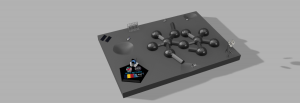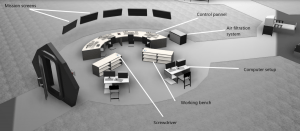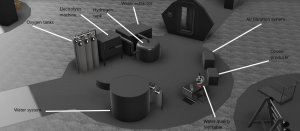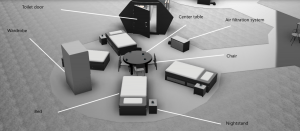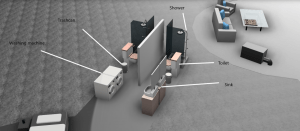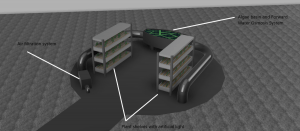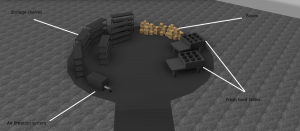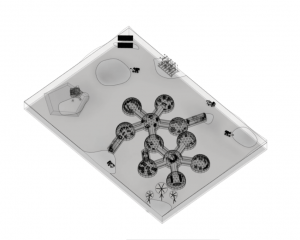Moon Camp Pioneers Gallery 2020-2021
In Moon Camp Pioneers each team’s mission is to 3D design a complete Moon Camp using Fusion 360. They also have to explain how they will use local resources, protect astronauts from the dangerous of space and describe the living and working facilities.
Team: Moon Settlers
Tudor Vianu National High School of Computer Science Bucharest Romania 15
External viewer for 3d project
|
Project description
Our moon camp is designed to be the first ever settlement for humans, being the gateway for future Moon exploration. Our base design has been chosen for scientific purposes, not leaving much room for anything else. Throughout history, colonization happened in three main phases. Fortunately, the first phase has already been completed due to the fact that humans have already been on the Satellite. Our base is part of the second phase in which humans set out an outpost which is still very much dependent on Earth. During this phase research and infrastructure needs to be built in order to prepare the celestial body for the final phase in which the colony, now fully independent, becomes autonomous from Earth. We saw all these phases during the colonialism era on Earth, when all of The New World was built up by the European powers in a similar manner as the Moon will be. To sum up, our base is the first step of the second phase of Moon colonization, therefore making it the beginning of a new age of space exploration and human development. |
|||
|
Where do you want to build your Moon Camp?
When it comes to where our base should be located, we immediately thought of a place with ice water nearby. During our scientific research, we came to the conclusion that our base should be located right next to a crater from the poles. Our best candidate is Clavius, one of the largest craters visible from Earth in the Moon’s southern hemisphere. With ice water discovered on its surface, there might be a chance water may be distributed across the lunar surface, and not limited to cold, shadowed places. Being placed next to Clavius, our crew will be able to test this hypothesis. How do you plan to build your Moon Camp? Describe the techniques and materials you would use.
The Moon is the sole Satellite of Earth. Our project utilizes all of its resources whilst keeping costs low and living conditions good for the astronauts. First of all, in order to reduce costs, we made our base modular so it can be quickly constructed and easily expendable. Our domes are based on pentagons, being made of triangles which can be prefabricated on Earth. The corridors leading from one room to the other are made of long metal sheets which can also be brought from Earth. Second of all, after construction, our base will be covered by a regolith layer which will protect the entire base from radiation and small meteorites. The tunnels leading out will contain an anti-radiation layer. Keeping in mind the quality to price proportions, our design will use the same furniture where possible. Furthermore, the design contains a one-meter foundation in order to stabilize the structure and protect the base from potential earthquakes caused by meteorite crashes. The construction will solely be done by robots, human labor being much more expensive and much less efficient, therefore in the first phases of construction humans will not have even arrived on site. To sum up, our base will be cost efficient and easy to construct, whilst keeping its high quality and short construction time. The environment on the Moon is very dangerous for the astronauts. Explain how your Moon Camp will protect them.
During the early stages of construction, humans will not even be on the Moon yet, so the risk of injury during construction has been fully eliminated. Being covered by a layer of regolith, radiation will be no problem in the interior of the base. The corridors leading out of the base have a radiation protection layer, making them radiation proof as well.. The regolith layer will not only offer radiation protection, but will also protect the astronauts from small meteorites which crash on the moon’s surface. Our design also contains a rover for personnel which will protect the crew and shorten trips during various scientific missions. In conclusion, due to all the aforementioned reasons, our base is designed to protect the crew from all dangers encountered on the moon. Explain how your Moon Camp will provide the astronauts with:
|
|||
|
Water
|
Food
|
Electricity
|
Air
|
|
Providing water for our base will not be an easy task, we will send a rover with mining equipment to remove the ice contained in the craters located at the satellite poles. We will use a hot and powerful tool to dig into the surface of the moon. Then, the ice will be taken to the base, where it will be melted using solar energy. The collected water will be filtered from other particles, therefore making it drinkable. Moreover, many sources of recyclable water, such as urine and hygienic water occur at the foundation. In order to clean water, we will first use a species of algae. This method, in combination with ‘Forward Osmosis Concentration’, a technique created by NASA, will assure water is drinkable again. This method consists of the use of a semi-permeable membrane which separates the salt water and the large organic molecules from the drinking water. |
So as to get the necessary supply of food in the early stages of construction, our base will import almost everything from Earth. The base hosts a food dome in which plants will be grown in shelf-like conditions, exactly the same as in vertical farms which are starting to become popular back on Earth due to energy saving and cost efficiency. Small plants will be harvested, using only needed wavelengths for their growth. Moreover, this way of growing fresh food facilitates water saving and brings freshness to our astronaut’s diets. The dome will also contain an algae basin which will provide food and oxygen for our base, whilst ensuring that no beneficial nutrients are wasted. However, not all food will be provided from our food growth chamber, packaged food similar to the one the ISS uses will be imported in order to be sure needed vitamins and minerals can be provided. |
In order to get the required amount of energy to power the base and its various extensions we thought that the easiest and cheapest way is by utilizing solar energy in combination with batteries which will allow the base to function during the lunar night. Taking into consideration that solar energy is our only way of procuring energy, we thought that around 250 solar panels, of which 50 are back-up, will be enough to power the base day and night. 100 panels will be enough to maintain the needed energy during the day, whilst the other 100 will be filling up the batteries in preparation for the night to come. In conclusion we think that this is a cheap way to maintain our camp fully working all around the clock. |
We will assure air is breathable in a plan consisting of two phases. The first phase covers the early days of our base. During this period, air will be provided by Earth. Additionally, compressed H2 will also be shipped for future processes. The second phase takes advantage of the 41 to 45 percent of O2 the lunar regolith consists of. Combining the oxides contained in the regolith with the H2 shipped from earth, all whilst it gets heated up to around 950°C, we will make a chemical reaction which will create water and other metal alloys which can be used in construction. Furthermore, the water is going to be electrolyzed in order to get O2 and H2 which will ultimately be recycled in order to produce future needed O2. When talking about N2, current research shows little composition in the lunar soil, ultimately constraining our base to importing it from Earth. |
|
Explain what would be the main purpose of your Moon Camp (for example: commercial, scientific, and/or tourist purposes).
Our design choice is solely for scientific purpose, the base being able to sustain only a crew of 4 people. This build will only host scientists which will set up the infrastructure for future bigger bases as well as study the composition of lunar rocks. Using the metal alloys from the production of O2 our base can create its own materials. If zones with an abundance of minerals scarce on Earth will be discovered, it might be cheaper to extract them on the moon with our rovers which will ultimately bring more funding and interest in space exploration. Being easily expandable, our base can also become the beginning of a complex structure which will be able to sustain human life not only for scientific purposes. Tourism is a very good candidate for this due to the huge amount of money attainable this way. |
|||
|
Describe a day on the Moon for your Moon Camp astronaut crew.
During their stay on our base, the crew will have a very intensive schedule they will have to follow in order to keep the base up and running. First of all, before they get started on their tasks, they will first have time for their morning routine (teeth brushing, showering, taking vitamin and mineral supplements, etc.). Before eating breakfast, they will have a workout in the gym in order to keep bone damage due to a lower gravitational pull to a minimum. Breakfast will be served in the kitchen dome, containing fresh food and astronaut food from the storage. Second of all, there will be two main working periods, one before lunch and one in between lunch and dinner. During these time periods, our crew will do rover mining, research and distant missions from the base. Rock composition studies will be conducted using the microscopes from the research module. Distant mission will be carried out using the personnel rovers which will have multiple oxygen refill tubes. Mining with our mining rovers will be done from the base remotely from rover control, using the specialized rovers equipped with many different sensors. It is important rover mining and missions are conducted in the morning, due to the complexity of the tasks which require the full attention and concentration of the crew. Lunch will be served in the kitchen dome, after which there will be a small period of free time. Tasks begin immediately afterwards, with rover maintenance and plant harvesting (only the plants fit for this). The solar panels and Water & O2 system will also be checked to see if any part should be removed or replaced. This maintenance checkup is very important to make sure the base is fit for running. Before dinner, there will be time for a workout in the gym for the same reasons as in the morning. After dinner there will only be free time as well as a period to facetime families back at home. Our common area will include family games for fun afternoons, books for reading and studying, a chess board as well as a TV with the astronaut’s favorite TV shows and movies. There will also be a once per month health checkup to monitor the crew’s fitness for work. To sum up, our crew’s schedules will be filled to the brim with activities and tasks, covering all the needed work to keep the base going. |
|||







